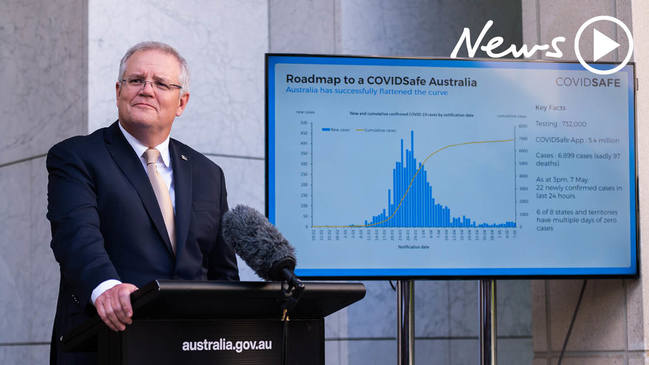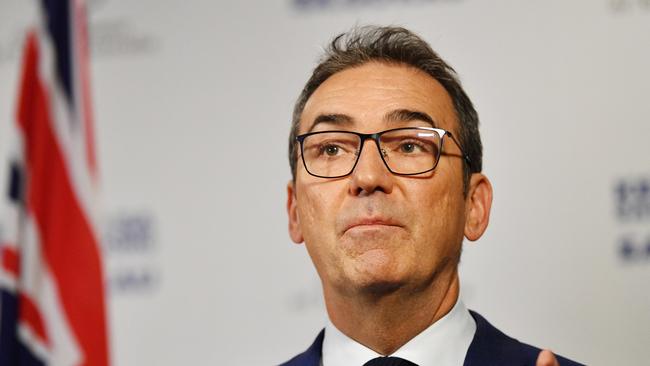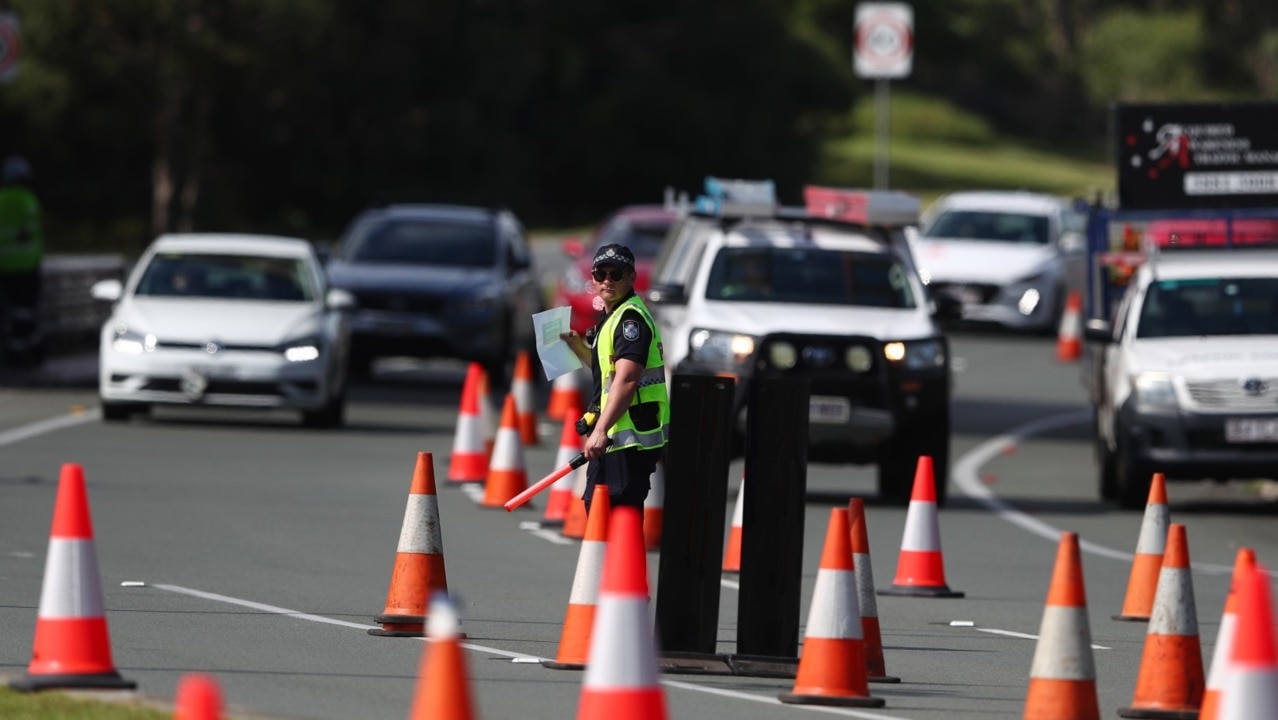SA restrictions eased on footy this weekend and venues from Monday, as more resources sent to secure Victorian border
Thousands of fans at Adelaide Oval, and pubs and restaurants operating at 50 per cent capacity – life in SA will become much more normal from Monday. But the news isn’t so good for people eager to cross the border. READ THE NEW RULES

Coronavirus News
Don't miss out on the headlines from Coronavirus News. Followed categories will be added to My News.
- SA’s plans to deal with a second wave of cases
- Read all our local and international coronavirus coverage
Life almost as we knew it returns to South Australia next week, when you can again have a beer at a bar, crowds of 25,000 will be allowed at Adelaide Oval and business and restaurant capacity can double.
Premier Steven Marshall said SA would be “more open than any other place in the country, and pretty much any place in the world”, when a third phase of lockdown-lifting starts on Monday.
SA is also beefing up border checks to keep out growing clusters and outbreaks detected in Victoria over the past week.
After a meeting of SA’s powerful transition committee, Mr Marshall on Tuesday announced the state would accelerate through the national road map for easing restrictions and hit phase three next Monday.
The accelerated shift allows the opening of food courts, contact indoor sport competitions and gaming rooms. But the key change is an additional rewrite to indoor-distancing rules, which had frustrated businesses.
Instead of having a maximum of one person for every 4sq m, venues of almost all kinds will be allowed one every 2sq m. That doubles the number of customers they can take, lifting capacity to about half of what they had before lockdowns.

There is no formal fourth phase in the lockdown-lifting road map. Higher-risk activities in a “future steps” group include large outdoor gatherings, salad bars and buffets, shisha businesses and nightclubs. They can now make special application to operate.
Those plans will be vetted by SA Health before any approvals are granted.
That process also applies to outdoor gatherings of more than 500, allowing those venues up to half their normal capacity, with precautions.
Adelaide Oval and the sports that play there have now been challenged to come up with guidelines that could safely welcome such a crowd, a maximum of about 25,000.
Permission has been granted for 5000 people a day to attend two SANFL double-headers on Saturday and Sunday before the new rules come in. The matches are seen as key test cases.
Fans and Oval management were given an excellent report card from health authorities after the pilot 2240 crowd for the AFL Showdown.
SA Health has examined a specific plan put forward by Adelaide Casino.
Mr Marshall said the Government would continue to monitor health results from around the country and keep a tight watch on the Victorian border but was moving to open up local jobs and life.

“SA is more open than any other place in the country, and pretty much any place in the world,” he told The Advertiser. “This means that we will be able to get as many people back to work in a COVID-safe environment as possible.
“We’ve been moving in this direction for a long period of time. SA has been doing extraordinarily well. Now we have reward for that good work.
“Many thousands of people will be back to work.”
Mr Marshall said SA had set itself apart and shown unique character in the battle.
SA Health is urging continuing observance of social distancing, that people who feel ill seek tests, and good hygiene.
Extra police checkpoints are being set up to monitor people coming in from Victoria and NSW. People who claim to be essential travellers, and therefore exempt from quarantine requirements, will now need pre-approval to come in.
Non-essential travellers from NSW and Victoria are still required to quarantine.
SA borders are open to Tasmania, Queensland, the NT and WA, but those states have restrictions for SA people entering. Citizens returning home from overseas will also be welcomed in the next few weeks, via supervised quarantine.
SA plans to reopen all interstate borders from July 20 but the Victorian crossing is under constant review.
Business SA chief executive Martin Haese said the new square-metre rule was a “win”.
“Business SA’s poll of more than 300 businesses found the impact of the one person per 4sq m rule was holding businesses back across a broad range of industries, not just hospitality,” he said.
Australian Hotels Association SA chief executive Ian Horne said many pubs would be able to conduct business close to usual with 50 per cent capacity but miss out on larger pre-COVID weekend crowds.
“Stand-up drinking is a significant positive step,” he said. “You’ll be able to stand at the bar, in the beer garden or around the eight-ball table.
“It’s going to make going to the pub or the club or the bar more normal.”
After arriving at phase three on Monday, Mr Marshall said SA would be in a kind of “new normal” that could still last a long time as treatments to combat the virus evolved. City-based Mississippi Moon bar owner Michael West said: “It is very good news for the business financially, good for the staff and … customers. It will bring more atmosphere.”

Marshall’s plan for reopening depends on public confidence
Analysis – Daniel Wills
After more than three long months of COVID lockdowns, SA is now jumping right into what becomes the new normal.
When a panicked Australia started shutting up in March, there were dire predictions of a massive death toll and a complete up-ending of life as we knew it for a very long time.
Now SA is rushing to become the most economically open state and boasts a health record that hasn’t been seen anywhere else in the world. Premier Steven Marshall has struck the most tender of balances through this process.
From day to day, there were claims that SA wasn’t locking down fast enough to save lives or opening quickly enough to save jobs. Having achieved the first, the stops are now being pulled out to assure the second.
Politics went out of the window during the most intense period of national crisis. Everyone was united in desperately trying to find a way through circumstances that this generation has only read about.
But that solidarity has begun to fray, as the health emergency eases and premiers around the nation look to their own political interest.
WA Premier Mark McGowan is throwing red meat to his separatist state with daily grandstanding over tough borders. NSW Premier Gladys Berejiklian is telling business there not to serve Victorians coming from hot spots.
Besieged Victorian Premier Daniel Andrews took a silly and distractionary potshot at us, only to be met with a humble offer of expert SA health professionals who can get his own house in order.
In more easygoing SA, where Mr Marshall’s toned-down pleas for public co-operation proved far more effective, our political battle also has a different focus.
Job creation has been the biggest issue in SA for decades.
Amid the turmoil of Holden closing and shelving of the Olympic Dam expansion, failure to deliver on jobs cost the Labor government its tenure.
As life starts to return to normal, the same issue will again dominate local politics.
While few would blame Mr Marshall for the nearly 50,000 jobs already confirmed to have been lost during SA lockdowns caused by a global pandemic, they’ll watch closely how he handles the necessary rebuild.
By getting as much business back up and going as possible, he’s putting a lot of faith in the market to do what it does and recover through innovation.
Mishandling the health crisis would have been a political disaster. Instead, Mr Marshall used the time to build trust in his administration’s basic competency and become much better known in the average South Australian loungeroom.
The game now is all about public confidence to go out and spend. His own job, along with thousands of others, relies on this.
